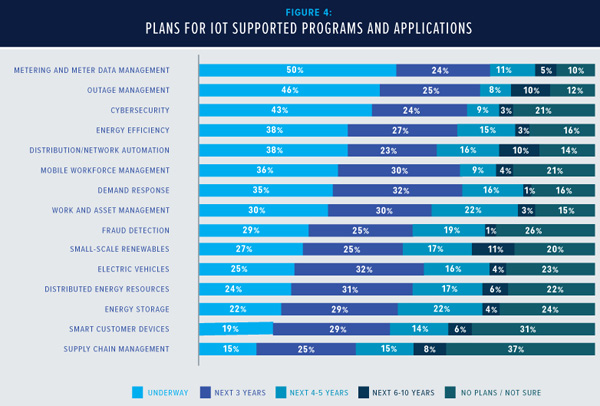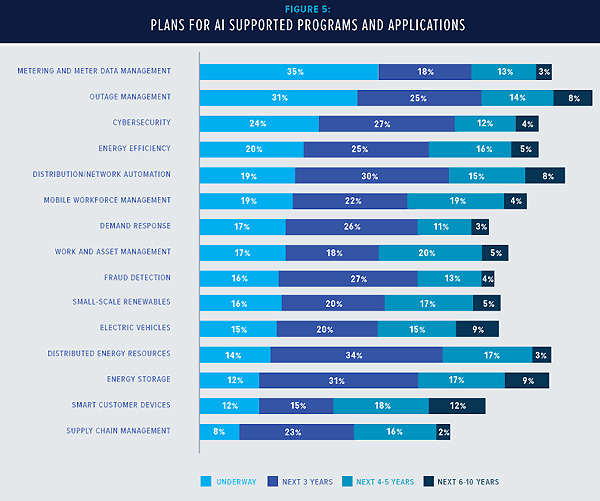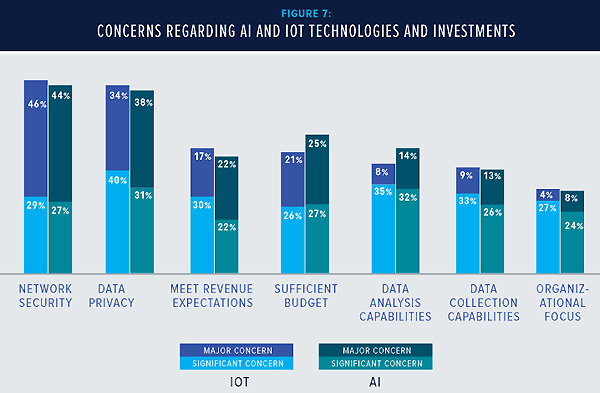A new report by Zpryme says utilities have recognized both the massive amounts of data now being generated by the proliferating “internet of things,” the potential it represents for improving grid responsiveness, and the need to take advantage of it to improve service. In response, it says, while in some respects they’re still in the early stages, utilities are getting ready to make use of the growing capacity of computer systems to exploit that data.
 With the increasing complexity of grid management, the report comments, the higher customer experience demands, and the proliferation of distributed energy resources, “utilities will need to put large amounts of data to work. Keeping a distributed grid balanced will require a speed of analysis far beyond that of humans alone, and decision-making that can only be accomplished through a fusion of intelligent devices and artificial intelligence.” Using IoT devices in the home and throughout the grid, the report says, will allow AI to strategically analyze the myriad of different systems and find connections between them to improve outcomes. This should invariably lead to better engagement as energy efficiency and renewable programs spark a new connection between the utilities and their customers.
With the increasing complexity of grid management, the report comments, the higher customer experience demands, and the proliferation of distributed energy resources, “utilities will need to put large amounts of data to work. Keeping a distributed grid balanced will require a speed of analysis far beyond that of humans alone, and decision-making that can only be accomplished through a fusion of intelligent devices and artificial intelligence.” Using IoT devices in the home and throughout the grid, the report says, will allow AI to strategically analyze the myriad of different systems and find connections between them to improve outcomes. This should invariably lead to better engagement as energy efficiency and renewable programs spark a new connection between the utilities and their customers.
 At the end of 2018, the report finds, more utilities have deployed IoT technology, especially with their ongoing use of smart meters, than AI. Artificial intelligence is a rapidly growing field, using developing techniques like neural networks and deep machine learning, where ever more powerful computer systems can now digest torrents of data to understand system behaviour in real time, in ways that surpass the capabilities of human operators. But the Zpryme report says that, “[w]hile most utilities are not currently using AI and IoT in tandem, there are some exciting examples from companies that are leading the way.
At the end of 2018, the report finds, more utilities have deployed IoT technology, especially with their ongoing use of smart meters, than AI. Artificial intelligence is a rapidly growing field, using developing techniques like neural networks and deep machine learning, where ever more powerful computer systems can now digest torrents of data to understand system behaviour in real time, in ways that surpass the capabilities of human operators. But the Zpryme report says that, “[w]hile most utilities are not currently using AI and IoT in tandem, there are some exciting examples from companies that are leading the way.
“Our focus has been automation and analytics,” said one survey respondent. “We are using our AMI program to create an asset failure prediction model that is helping us make better decisions. However, we still have a long way to go as an organization to ensure that our people have been trained to make data available for everyone who needs it. The hardest thing is managing the data when there’s petabytes available. The key is to get in a system where people can get the data from disparate sources.”
 Running the two concepts together, the report says AIoT will be highly beneficial for improved outage management systems, advanced demand response, and distributed energy resource management systems. These technologies will be at the forefront of the next wave of “green” utility modernization efforts, it says. It’s also likely to be used to address network security concerns, a present and growing concern (Figure 7).
Running the two concepts together, the report says AIoT will be highly beneficial for improved outage management systems, advanced demand response, and distributed energy resource management systems. These technologies will be at the forefront of the next wave of “green” utility modernization efforts, it says. It’s also likely to be used to address network security concerns, a present and growing concern (Figure 7).
